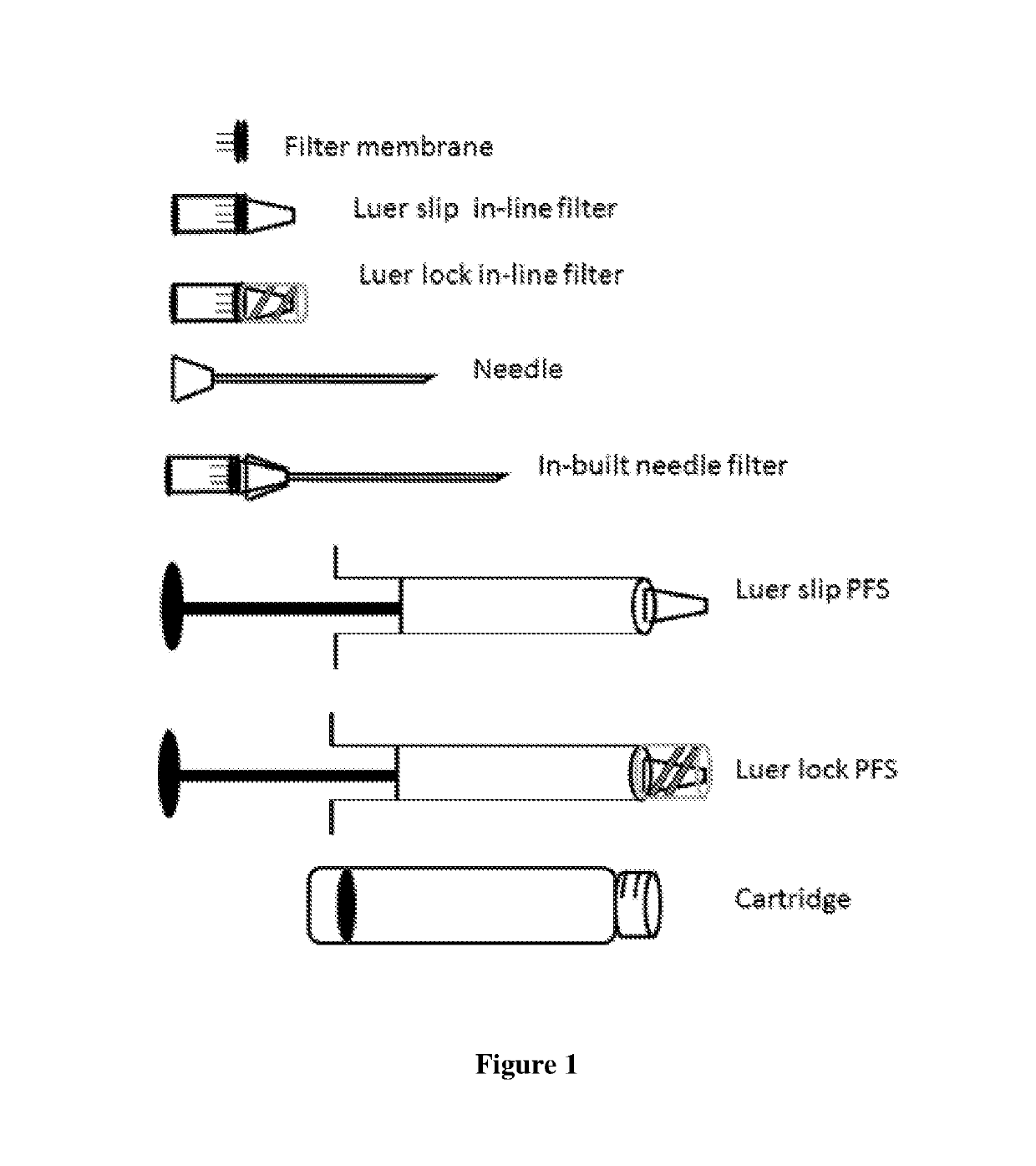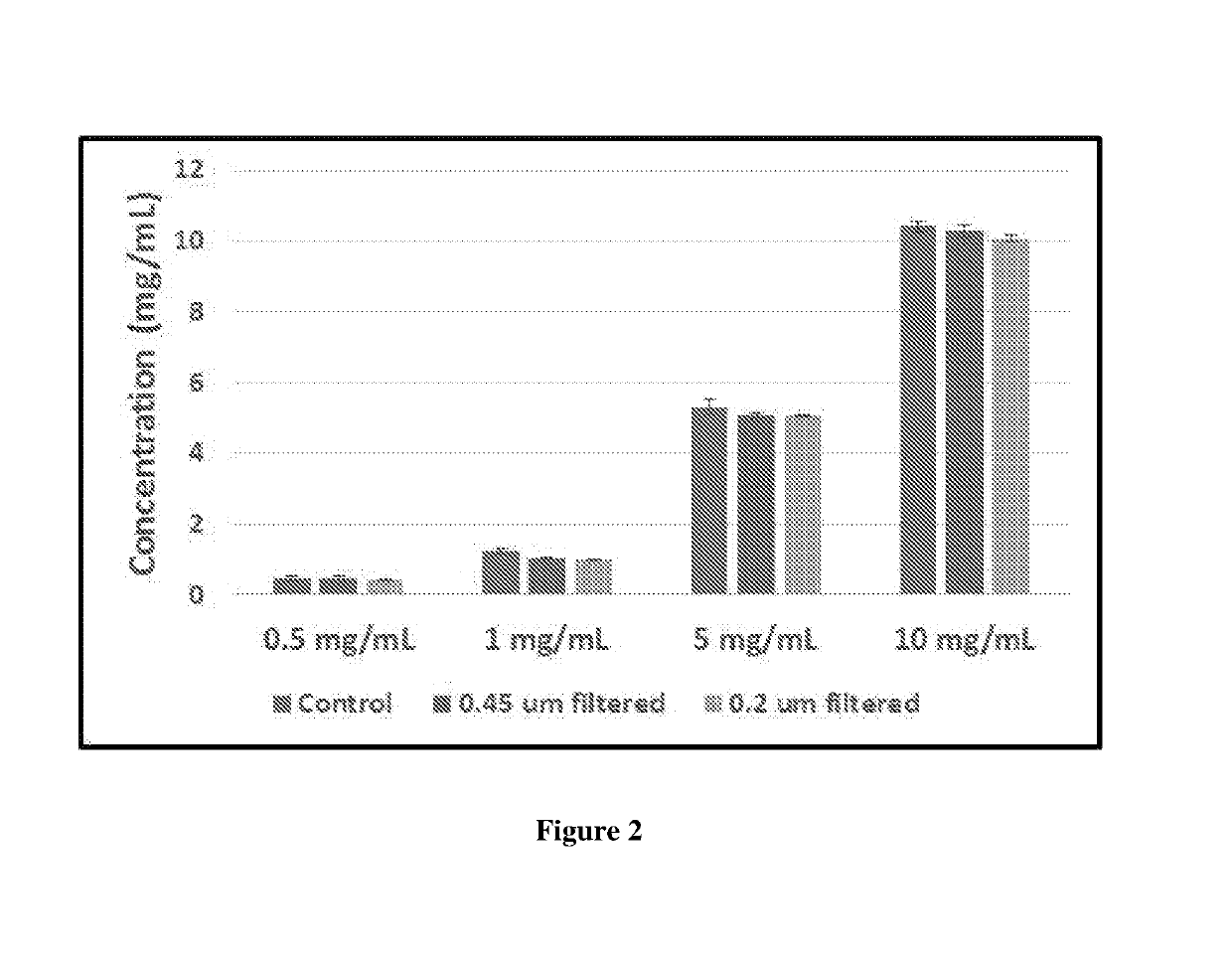In-Line Filter For Protein/Peptide Drug Administration
a protein/peptide drug and filter technology, applied in the direction of filtration separation, medical devices, antibody ingredients, etc., can solve the problems of reducing the number of particles, and preventing the introduction or generation of protein and non-protein based particles. , to achieve the effect of convenient administration, and reducing the number of particles
- Summary
- Abstract
- Description
- Claims
- Application Information
AI Technical Summary
Benefits of technology
Problems solved by technology
Method used
Image
Examples
example 1
n of Reduction in Total Particulate Count using Needle with In-Line Filter
[0054]Ranibizumab binds to VEGF and prevents VEGF interaction with cognate receptors. Ranibizumab is Fab fragment designed for intravitreal injection to treat macular degeneration. Ranibizumab drug substance in formulation buffer was subjected to UV exposure for 3 hours to generate proteinaceous particles and filled into Pre-filled Syringe (PFS) of different make coated with different levels of silicone oil. After overnight incubation at room temperature, PFS contents were emptied manually with or without in-line filtration in a Class 100 environment. Particle count was measured using Light obscuration (LO) spectroscopy. For comparative purpose, here we used two different makes of PFS and 3 different makes of in-line filters of which one filter was in-line with needle (needle with built in filter).
[0055]Result: Contents from the PFS was emptied into a clean container in a laminar flow hood (Class 100 workstati...
example 2
g the Efficacy of In-Line Syringe (Liters in Removing Silicone Oil Droplets
[0056]The efficacy of in-line syringe filters to capture silicone oil particles was tested with a 200 μg / ml silicone oil emulsion challenge test. In this study, 200 μg / ml silicone oil emulsion was prepared in Ranibizumab formulation buffer, 1 ml of which was aspirated in 1 ml Tuberculin syringe. The syringe was attached to 0.45 μm cut-off in-line PVDF / PES syringe filter and the contents emptied into clean Eppendorf tubes. Silicone oil emulsion (SOE), and samples through the in-line syringe filters were analyzed for sub-visible particulate matter by MicroFlow Imaging (MFI).
[0057]Particle concentration in cumulative size bins ≥5 μm, ≥10 μm, ≥25 μm and ≥50 μm are reported in this study.
[0058]Result: It was observed that 0.45 μm PVDF in-line syringe filters efficaciously captured silicone oil particles and caused a significant reduction of silicone oil particles present in original samples containing 200 μg / ml si...
example 3
g the Efficacy of In-Line Syringe Filters in Removing Sub-Visible Ranibizumab Aggregates
[0059]In this study, the efficacy of 0.45 μm cut-off in-line PVDF in-line syringe filter in capturing sub-visible Ranibizumab aggregates were evaluated. Ranibizumab Drug Product (0.23 ml in vial) was incubated at 70° C. for 6 hours to generate sub-visible aggregate. Then the contents of three vials were pooled and aspirated into siliconized prefillable syringe. The in-line syringe filter was then connected to 30G×½″ needle and the content emptied into clean Eppendorf tubes. Aggregated Ranibizumab samples and filtered aggregated Ranibizumab samples in addition to control unstressed Ranibizumab drug product were tested for particulate matter by MFI.
[0060]Result: It was observed that 0.45 μm PVDF in-line syringe filters significantly reduced the concentration of sub-visible particles in cumulative size bins ≥5 μm, ≥10 μm and ≥25 μm. Sub-visible particles ≥50 μm observed in heat stressed Ranibizumab ...
PUM
| Property | Measurement | Unit |
|---|---|---|
| Fraction | aaaaa | aaaaa |
| Pore size | aaaaa | aaaaa |
| Pore size | aaaaa | aaaaa |
Abstract
Description
Claims
Application Information
 Login to View More
Login to View More - R&D
- Intellectual Property
- Life Sciences
- Materials
- Tech Scout
- Unparalleled Data Quality
- Higher Quality Content
- 60% Fewer Hallucinations
Browse by: Latest US Patents, China's latest patents, Technical Efficacy Thesaurus, Application Domain, Technology Topic, Popular Technical Reports.
© 2025 PatSnap. All rights reserved.Legal|Privacy policy|Modern Slavery Act Transparency Statement|Sitemap|About US| Contact US: help@patsnap.com


